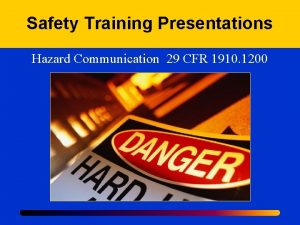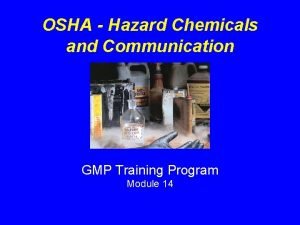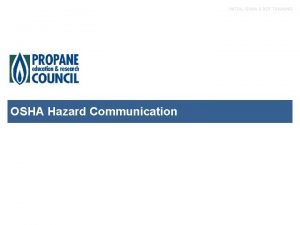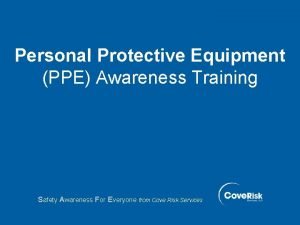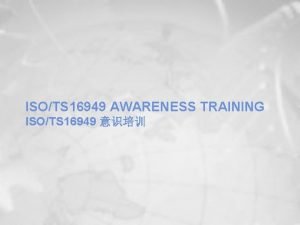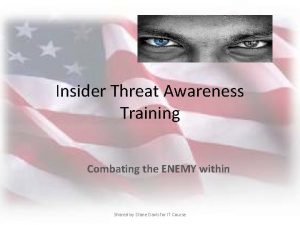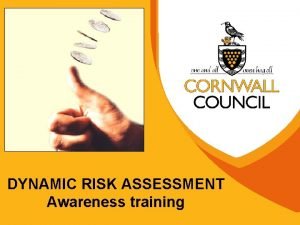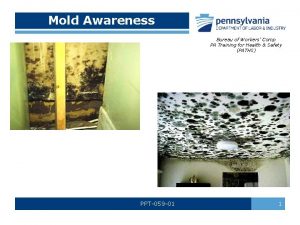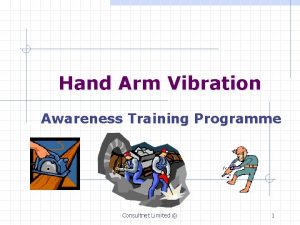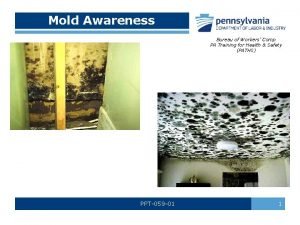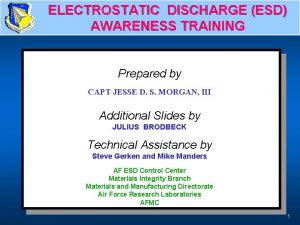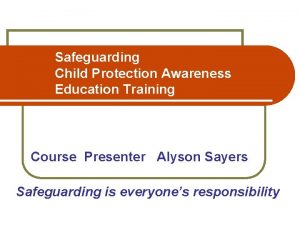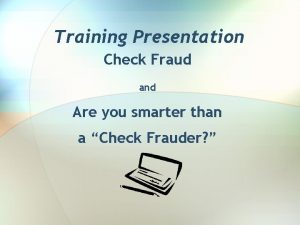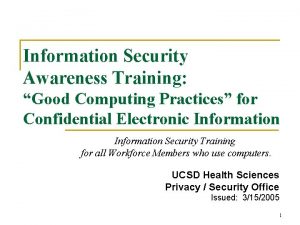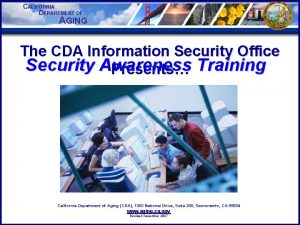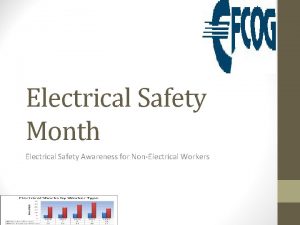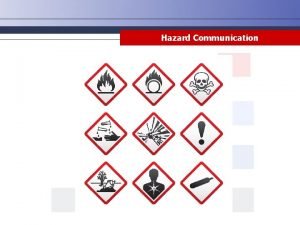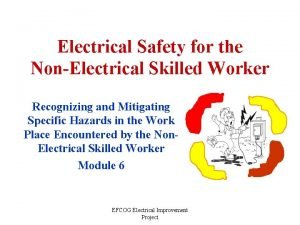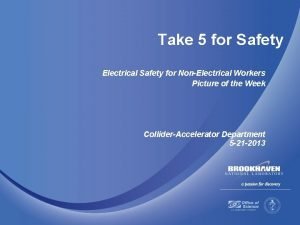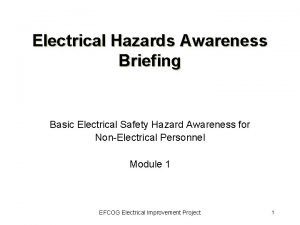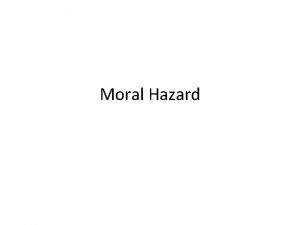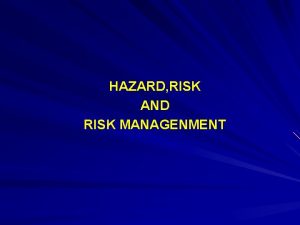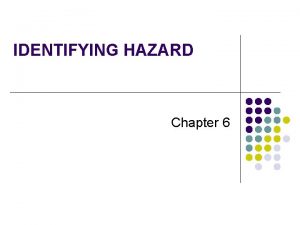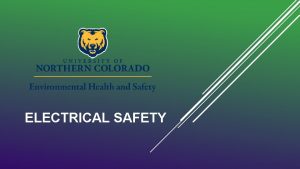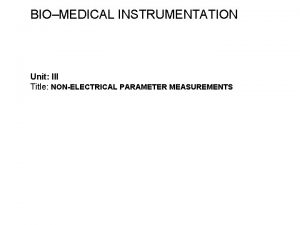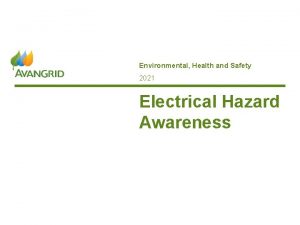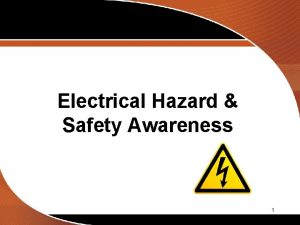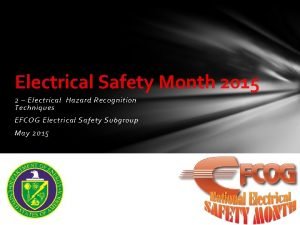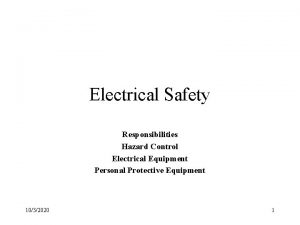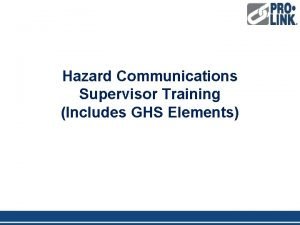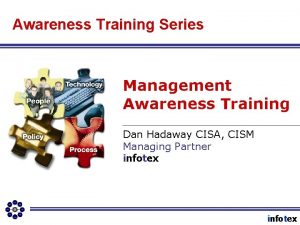Electrical Hazard Awareness Training for NonElectrical Workers Please

































































































- Slides: 97

Electrical Hazard Awareness Training for Non-Electrical Workers Please view slides in “Notes Page. ” Go to “View” then choose “Notes Page. ” 1

Electrical Hazard Awareness –Why? Electrical thermal burns cause injuries to skin surfaces; electrical burns can also cause internal burns to vital organs, arc flash burns, flame burns, contact burns (thermal burns) or a combination thereof. • Electricity is an unseen killer: – It is invisible to the human eye – Doesn't make any sound – Gives off no odor 2

Statistics The National Institute for Occupational Safety and Health (NIOSH) reported that from 1992 through 2002: 1. Contact with overhead power lines was the most common cause of electrocutions, resulting in 42% of all on-the-job electrical deaths. 2. The second most common cause of electrocutions was failure to properly de-energize electrical equipment. 3. The third most common cause was contact with electrical components mistakenly thought to be deenergized due to a mistake in wiring or re-wiring, or misidentified wiring. 4. Contact with buried, underground power lines caused 1% of the fatalities. 3

Examples of Electrical Injuries Entrance Wound Exit Wound Arc Flash Thermal Contact Burns 4

NFPA 70 E, Standard for Electrical Safety in the Workplace • Training requirement: – Training must be provided to employees who face a risk from electrical hazards. • Training components: – Identify and understand the relationship between electrical hazards and possible injury. – Understand the safety related work practices and procedures as well as any practices deemed necessary for avoiding electrical hazards which can cause personal injury or death. 5

Electrical Safety Awareness Training • Basic minimum requirement for “non-energized” and “unqualified” workers • NOT sufficient for anyone working on or near exposed energized electrical conductors • Additional training is required for those employees who work on energized electrical systems. 6

Electrical Safety Training Levels All workers must receive training on electrical hazards depending on the type of work performed. The three levels of electrical safety training are: 1. Unqualified worker electrical safety hazard awareness 2. Qualified Worker specialized training in safe work practices and procedural requirements to provide protection against electrical hazards associated with individual job tasks 3. Emergency response 7

Unqualified Workers • Unqualified worker electrical safety hazard awareness – Identify and understand the relationship between electrical hazards and possible serious personal injury – Unqualified workers “shall be trained in and familiar with any electrical safety related practices necessary for their safety” 8

Qualified Workers • Qualified worker is someone who has specialized training in safe work practices and procedural requirements to provide knowledge necessary to understand the hazards and be able to identify protective measures against electrical hazards associated with individual job tasks – Skills-based training which complement and address specialized knowledge 9

Emergency Response • Emergency Response – Employees exposed to shock hazards and others responsible for taking emergency action – First aid and necessary emergency actions 10

Circuits and Conductors Electricity flows like a river in a pathway. These electrical pathways are called circuits. • A circuit must be complete or closed for electricity to flow. If the circuit is not, then it is considered an open circuit. • Any material that conducts electricity (i. e. , the human body) will be able to close an open circuit. • The earth, water, concrete, and the human body are all conductors of electricity 11

Types of Injuries Related to Contact With Electricity • Electrical shock- contact of a human body with any source of voltage high enough to cause sufficient current to pass through the muscles. • Electrocution- death due to electrical shock from interruption and stopping the heart and damage to brain function. • Injury due to Arc Flash: Burns due to radiant heat, arc flash, and flying melted electrical parts. • Falls- moving back after shock or thrown back by shock or arc. 12

What is Electricity? • Flow of electrons in a closed path which provide an energy source for powering equipment. • Electricity follows the path of least resistance. • How does electrocution occur? – A person contacts an electric pathway by contacting an energized circuit or conductor § Inadequate grounding 13

What is Electric Shock? • The body becomes part of the electrical circuit when in contact with an energized conductor; the person will receive a shock and loss of muscular control. • Severe shock can cause the heart and lungs to stop functioning and severe burns may occur where current enters and exits the body. 14

How is an Electric Shock Received? • When two conductors have potential differences (aka different voltages), current will flow if they are connected together. • Electric shock normally occurs when an individual contacts: – Both wires of an energized electric circuit. – One wire of an energized circuit and the ground. – A metallic part that has become energized by contact with an energized conductor. The metal parts of electric tools and machines may become energized if there is a break in the insulation of the tool or machine wiring. – Any conductor that is carrying current. 15

Why All Electric Shocks Should Be Avoided • Shocks can result in long term negative consequences. “While the total number of US occupational electrical injury cases is low, the risk of mortality and morbidity is disproportionately high. ”¹ – Contact with electric current has a lower number of non fatal workplace injuries when compared with other workplace injuries, but electrical mishaps causing lost time injuries are more likely to lead to a fatality than nearly all other mishaps. • Multiple hazards may create an injury in an electrical failure and yet not be fully recognized or documented. ¹ Serious injury/death Electrocution • Organ damage • Neurological disruption Shock Cellular effects ¹ Dr. Mary Capelli-Schelpfeffer, Journal of Disability 16 Medicine, Vol 10. No 1, Jan. - March 2014

Electrical Injury Mechanism from Shocks Unintentional or accidental electrical exposure Electric Power Loss of Energy Control Severity depends on: • How much energy flows. • How long the event lasts. • How energy is imparted to the affected person and nearby surroundings. Energy is transformed and transferred Physical harm to people and damage to essential equipment Adapted from article from Dr. Mary Capelli. Schelpfeffer, Journal of Disability Medicine, Vol 10. No 1, Jan. - March 2014 17

Multiple Bio-effects of Shocks from Electrical Current Courtesy of Dr. Mary Capelli-Schellpfeffer 18

Terms Which Describe Electricity • • Voltage - Force Current – Flow Conductors Resistance Arc Flash Arc Blast Ohm’s Law 19

Current and its Effect on the Human Body Current Reaction 1 milliamp Perception level of faint tingle 5 milliamps Slight shock, involuntary actions may lead to injuries 10 -50 milliamps Painful shock, muscular control lost, let-go threshold 50 -150 milliamps Individual cannot let go, severe shock, respiratory arrest 500 and above (0. 5 Severe burns, nerve damage, amps) ventricular fibrillation, cardiac arrest 1 amp = 1, 000 milliamps 20

Electricity Mishap Effects • Electrocution causing – Severe burns § Internal organ burns and external skin burns – Abnormal heart beat called fibrillation • • Fires Arc flash Arc blast Damaged or destroyed equipment 21

The Effects of Electric Current on the Human Body Depend on Several Factors • Circuit characteristics (current, resistance, frequency, and voltage) • Resistance of the body • The current’s path through the body determined by contact location and body chemistry • Duration of contact • Environmental conditions that affect the body’s contact resistance 22

Electrical Injuries Types 1. Fatal electrocution 2. Electric shock 3. Burns 4. Falls Traumatic Effects • Permanent nerve damage, including paralysis • Loss of muscle, skin, or other tissue due to burns and/or necrosis • Loss of a digit or limb • Severe burn scarring and disfigurement • Brain damage Low voltage does not mean low hazard 23

Electricity Can Harm in Many Ways (5) Arc Flash - External burns, shrapnel, thermal blast (1) Electric Shock - Nervous system - brain, heart, breathing (2) Contact burns (3) Electric shock muscle effects, reflex action, no-let-go (4) Internal burns Photo courtesy Lloyd Gordon, Ph. D, Dept. of Energy 24

Since We Work Around Electricity Every Day, We Forget How Dangerous It Can Be • Contact with overhead power lines is the leading cause of on-the-job electrical death • 43 percent of all occupational electrical fatalities from 2003 to 2007 in the U. S. were from contact with overhead power lines • However, only two percent of nonfatal electrical accidents occurred from worker contact with overhead power lines • Non-fatal electrical injuries are the 2 nd most costly workers comp claim (Electrical Safety Foundation International) 25

The Most Dangerous Locations To Use Electrical Equipment • Example of Electric Shock Drowning • Water conducts electricity 26

Electricity Can Cause Death By: • Fibrillation of the heart without immediate emergency response • Reflex action resulting in falls • Internal burn injury resulting in organ failure • Respiratory arrest leading to suffocation • Severe neurological damage • Severe burn injury to the outside of the body • Force of an arc blast including shrapnel 27

What Primarily Causes Electrocution? • • Contact with overhead power lines Contact with live circuits in panels Poorly maintained cords and tools Lightning strikes Trained electrician servicing an electrical panel 28

Injury from Facility Arc Flash - Working Without Qualification and Authorization • Electrical hazards can cause injuries which are debilitating, slow to heal and extremely costly • You can be seriously injured or killed • A person touching an energized conductor is always in danger of possible electrocution 29

Four Main Types of Electrical Injuries • Shock • Burns • Falls due to contact with electricity • Electrocution (death) Aftermath from contact with power lines 30

National Electrical Standards • OSHA - Code of Federal Regulations • NEC - Standard for the safe installation of electrical wiring – Technical requirements for persons who design, install and inspect electrical system installations. • • NFPA 70 E – Published by the National Fire Protection Association, Standard for Electrical Safety in the Workplace® • Latest edition 2012, Electrical safety for persons working • Specifies personal protective equipment, establishing an electrically safe working condition, safe work practices for work involving electrical hazards, training, and general requirements for electrical safety related work practices National Electrical Safety Code ® – Safety requirements for workers in the generation and distribution of electricity and communication industry (utilities, line workers, cable TV workers) 31

Working With Electricity at Heights and Using Ladders • Falls are caused by accidental contact with electricity • Be aware! Maintain safe working distances with lines • The safest ladder to use around electricity is fiberglass Unsafe condition 32

NFPA 70 E-2012 Requirements for an Electrical Safety Program • Document and implement an electrical safety program appropriate for the electrical hazards, voltage, energy level and circuit conditions • Provide an awareness of electrical hazards for all persons who work in an environment with these hazards – Qualified workers § Skills and knowledge related to the construction and operation of electrical equipment or installations, or a specific work method and trained to recognize and avoid the hazards that may be present with respect to that equipment or work method. – “Unqualified” workers • Job briefings • Hazard identification and risk assessment • Training documentation and assessment of understanding 33

NFPA 70 E • Establishing electrically safe working conditions • Limited, restricted and prohibited approach shock protection boundaries • Arc flash boundary • Qualified persons – One who has skills and knowledge related to the construction and operation of electrical equipment and installations and have received training to recognize the hazards and required control measures • Unqualified persons - all others 34

OSHA Electrical Safety Requirements • The Occupational Safety and Health Administration (OSHA) sets federal requirements for electrical safety based on NFPA 70 E for electrical safety programs • Training requirements: – Specific requirements called Lockout/Tagout for controlling hazardous electrical energy – Employees shall be trained in and familiar with the safety-related work practices that pertain to their job assignments which are necessary for their safety 35

OSHA Electrical Safety Requirements (Cont’d. ) • Additional OSHA requirements: – Electrical protective equipment – Wiring design and protection – Wiring methods, components, and equipment for general use – Electrical equipment and installations – Hazardous (classified) locations • Use only tested and “approved equipment” 36

Electrically Safe Work Condition • Unqualified persons shall not work on energized equipment • A written permit and management authorization is required for energized work • All electrical circuit conductors and circuit parts shall be considered energized until the sources of energy are removed • All energized work must be performed by qualified persons • Testing circuits for current flow is energized work 37

Shock Protection Boundaries • Limited Approach Boundary – An approach limit from an energized conductor or circuit part within which a shock hazard exists. • Prohibited Approach Boundary – An approach limit at a distance from an exposed energized conductor or circuit part within which work is considered the same as making contact with the electrical conductor. • Restricted Approach Boundary – An approach limit at a distance from an exposed energized conductor or circuit part within which there is an increased risk of shock due to electrical arc-over with inadvertent movement for personnel working in close proximity to the energized conductor. 38

What are the Hazard Controls? Engineering controls are a part of the design that prevent the worker from being injured while using equipment containing a hazard. Administrative controls protect the worker when engineering controls are insufficient, not yet in place, or removed or disabled for testing or maintenance. These controls rely on the actions of the worker (i. e. , wearing personal protective equipment (PPE)). Hierarchy of Controls demonstrates the most effective to least effective method for reducing hazards which can cause personal injury: 1) Physically remove (eliminate) the hazard; 2) Replace (substitute) the hazard with a less dangerous condition; 3) Isolate or separate persons from the hazard through engineering controls and workplace design; 4) Change the way persons work (administrative controls); use special PPE to protect the worker. 39

40

Control of Electrical Hazardous Energy Engineering Controls • Enclosures • Breakers • Fuses • Grounding • GFCIs • Insulation • Interlocks Administrative Controls • Training • Work Controls - SOPs, LO/TO • Two person rule • Protective equipment • Warnings 41

Nationally Recognized Testing Laboratory (NRTL) • UL • Canadian Standards Association NRTLs, such as Underwriters Laboratories are third-party organizations recognized by OSHA as having the capability to provide product safety testing and certification services to manufacturers of a wide range of products for use in the American workplace. The use of NRTL approved equipment is required because these usually have inherently designed systems to prevent injury. 42

Ground-Fault Circuit Interrupters (GFCIs) • GFCIs interrupt the flow of electricity when an unintended electrical fault occurs. • Use of GFCIs is the most important factor for reducing electrocutions over the past twenty years. • GFCIs are required for all cord and plug connected equipment supplied by 125 volt, 15 -, 20 - or 30 -amp circuits. • GFCIs are required for all outdoor and indoor locations where damp or wet conditions could occur. 43

Electrical Protective Device • Circuit breakers and fuses are over current devices which shut off the electricity flow if an overload or ground-fault in the circuit occurs. Circuit breakers and fuses protect equipment and facilities. • Work done on circuit breakers and fuses should only be done be qualified workers. • The only device whose sole purpose is to protect people is the GFCI. 44

Inadequate Wiring Hazards • A hazard exists when a wire is too small to carry the current – If a tool draws more current than the cord can handle, a fire can occur without tripping the circuit breaker Wire Use Rated Ampacity Wire Gauge Low-voltage Lighting and Lamp Cords 10 Amps 18 Gauge Extension Cords 13 Amps 16 Gauge Light Fixtures, Lamps, Lighting Runs 15 Amps 14 Gauge Receptacles, 110 -volt Air Conditioners, Sump Pumps, Kitchen Appliances 20 Amps 12 Gauge Electric Clothes Dryers, 220 volt Window Air Conditioners, Built-in Ovens, Electric Water Heaters 30 Amps 10 Gauge 45

Grounding Hazards • Conductive parts of an electrical wiring system (tools, ceiling light fixtures, switch plates, conduits, etc. ) we touch should be at zero volts relative to ground. • Housing of motors, appliances, fixtures or tools that are improperly grounded may become energized. • If you come into contact with improperly grounded electrical device, you will be shocked. 46

Overhead Power Line Hazards • Death or serious injury occurs if an antenna comes into contact with overhead power lines. The safe distance for the antenna from the power line is two times the height of the antenna. • Accidental contact with overhead power lines kills people and causes many serious injuries every year. • Carpenters, painters, crane operators or anyone touching or contacting an overhead power line risks a serious or fatal electric shock. • Vehicles, plant machinery, or equipment should not be taken within 10 feet of power lines. 47

The Ground May Become Energized! • Electricity decreases with the resistance of the ground • As potential drops, fields develop around the electrified machine • If you step across a line of unequal potential, you could be electrocuted 48

Inspect Extension Cords • Remove damaged or frayed cords from service Ground prong broken off 49

Never daisy chain extension cords (plugging into each other) Never daisy chain multioutlet strips 50

Extension Cords One extension cord unapproved for its use is used to power multiple devices creating a fire hazard. Unsafe Use of Extension Cords • Using as permanent wiring. • Using unapproved extension cords. • Overloading power capabilities of the cord during temporary use. • Plugging one extension cord into another and another, etc. called “daisy chaining” • Using one surge protector/power strip to power another 51

Do not Block Breaker Panels and Other Facility Electrical Equipment Leave at Least 36 Inches Clearance in Front of Electrical Panels 52

Plugs • Never remove the ground pin (the third prong); this could lead to an electrical shock • Violation shown here is a power strip with a missing grounding prong 53

Exposed Conductors • Report exposed conductors or equipment with covers left off 54

Electrical Parts Live parts of electric equipment operating at 50 volts or more need guarding against accidental contact 55

Resources - Electrical Safety Websites • Center of Excellence for Electrical Safety - http: //www. lanl. gov/safety/electrical/ • OSHA - http: //www. osha. gov/index. html • OSHA NRTLs - http: //www. osha. gov/dts/otpca/nrtl/index. html • NFPA - http: //www. nfpa. org/ 56

Quiz for Electrical Hazard Awareness (Please view this portion of the presentation in “slide show view. ” After the question, advance to the next slide, then click on the slide to reveal the answer. ) Question 1. The most dangerous place to use electrical equipment is? A. B. C. D. Indoors Outdoors Near water Near other electrical equipment 57

The most dangerous place to use electrical equipment is: C. Near water See slide 26 58

Question 2. You discover the electrical cord for a drill has been damaged and some of the cord’s insulation is missing. You should? A. Wrap tape around the damaged spot to prevent electrical shocks. B. Check to see if the drill still works. C. Tag the drill out of service and notify the department responsible for equipment maintenance. D. Make sure that the cord does not come in contact with the floor. 59

You discover the electrical cord for a drill has been damaged and some of the cord’s insulation is missing. You should? C. Tag the drill “out of service” and notify the department responsible for equipment maintenance. If a power cord's insulation wears away just at the point where the cord enters the metal frame, contact between the current conductor and the metal frame could make the appliance energized. Touching the energized metal frame of the appliance while simultaneously touching a conductor causes the current to surge through the human body. See slide 49 60

Question 3. The safest ladder to use around electricity is: A. Wood B. Fiberglass C. Aluminum D. Step stool 61

The safest ladder to use around electricity is: B. Fiberglass Wood ladders are non-conductive but rot in moist conditions. Fiberglass ladders offer the best choice for long life and safety from electrical conductivity. See slide 32 62

Question 4. The earth, water, concrete and the human body are all conductors¹ of electricity. A. True B. False ¹Conductors allow electrons to flow freely. 63

The earth, water, concrete and the human body are all conductors of electricity. A. True See slide 11 64

Question 5. The extent of an electrical shock on the body depend upon all of the following EXCEPT: A. Current B. Path C. Duration D. Body weight 65

The extent of an electrical shock on the body depend upon all of the following EXCEPT: D. Body weight The extent of an electrical injury is determined by current, voltage strength, resistance to flow, the duration of contact with the source, the pathway of flow, and the type of current – Direct Current (DC) or Alternating Current (AC). See slides 20 & 22 66

Question 6. Injuries from electricity can include which of the following? A. Electric shock that may or may not result in electrocution but can result in cellular damage B. Falls C. Burns D. All of the above 67

Injuries from electricity can include which of the following? D. All of the above: cellular damage, falls, and thermal or internal burns to organs and tissue. See slides 16, 23, 24 and 30 68

Question 7. Open knock-outs on outlet boxes: A. Must be reported and repaired as soon as possible. B. Are permitted by OSHA. C. Are common because replacing knock outs is expensive. D. Pose no hazard as the electrical wiring has been rerouted. 69

Open knock outs on outlet boxes: A. Must be reported and repaired as soon as possible. openings in cabinets, boxes and fittings See slides 55 & 55 70

Question 8. Which of the following is acceptable by OSHA standards? A. An unqualified employee flipping tripped breakers in a breaker box B. Plugging an extension cord into a second extension cord C. Removing a ground pin if needed to plug into a two prong outlet D. A qualified person repairing an extension cord 71

Which of the following is acceptable by OSHA standards? D. A qualified person repairing an extension cord. To satisfy the requirements of the OSHA standards, a repair needs to restore the cord to its "approved" condition. “Approved" is defined as certified, listed, or labeled, or otherwise determined to be safe by a qualified testing laboratory. See slides 9 & 36 72

Question 9. Flexible cords can be used in the workplace: A. As a substitute for permanent wiring B. If the cords are run behind walls to reduce the chance of abrasion and damage C. If heavy or extra heavy duty cords are needed for temporary purposes D. If any obvious splices are repaired with electrical tape 73

Flexible cords can be used in the workplace: C. If heavy or extra heavy duty cords are needed for temporary purposes. See slides 50 and 51 74

Question 10. Power strips can be energized by extension cords A. True B. False 75

Power strips can be energized by extension cords. B. False A power strip must be connected directly into a wall outlet rather than an extension cord. Using an extension cord with a power strip is a dangerous situation which creates a risk of equipment failure and fires. See slide 50 76

Question 11. Every worker is responsible for recognizing electrical hazards and using electricity safely. A. True B. False 77

All workers are responsible to recognize electrical hazards they may be exposed to and to use electrical power safely everyday. A. True See slides 1 -3 78

Question 12. Electrical components which are not properly grounded may create electrical shocks: A. True B. False 79

Electrical components which are not properly grounded may create electrical shocks. A. True No Grounding Conductor – Fault current in tool flows through the worker. Current Hot conductor Neutral conductor See slide 46 80

Question 13. Electrical current passes through body only when there is a potential difference: A. True B. False 81

Electrical current passes through the body only when there is a potential difference. A. True Electron flow is the current. Voltage is the force behind electron flow. Potential difference is a way of expressing the voltage. When there is a difference in potential difference, current flows. See slides 13 -15 82

Question 14. High voltage shocks cause electrical burns A. True B. False 83

High voltage shocks cause electrical burns A. True Link to Facts about Electric Burns and other Electrical Injuries: http: //dermaamin. com/site/atlas-of-dermatology/5 -e/416 -electric-burn-. html See slide 4 84

Question 15. Electrical burn injuries are caused by electrical fires from a short circuit. A. True B. False 85

Electrical burn injuries to skin surfaces are caused by electrical fires from a short circuit. B. False Thermal burns cause injuries to skin surfaces; electrical burns can also cause internal burns to vital organs, arc flash burns, flame burns, contact burns (thermal burns) or a combination thereof. See slides 2 an 4 86

Question 16. The severity of the injury caused by the electric shock: A. Is independent of the magnitude of the electrical current passing into the body. B. Depends on the voltage magnitude. C. Depends only on the resistance of the skin surface. D. Depends on the amount of current and length of time the current flows through the body. 87

The severity of the injury caused by the electric shock is: D. Depends on the amount of current and length of time the current flows through the body. See slides 13 an 14 88

Question 17. A severe shock can cause much more damage to the body than is visible. A. True B. False 89

A severe shock can cause much more damage to the body than is visible. A. True Persons may suffer internal injuries and long term adverse effects on tissues, nerves, and muscles for electrical shocks. Hidden injuries caused by electrical shock may result in a delayed response. Even if the electrical current does not cause immediate injury, reaction to the shock may cause one to fall, resulting in severe injuries. See slides 17 an 18 90

Question 18. The correct order for the hierarchy of controls from best to worst is: A. PPE, Administrative Controls, Engineering Controls, Substitution. B. Administrative Controls, Engineering Controls, Administrative Controls, Elimination. C. Elimination, Substitution, Engineering Controls, Administrative Controls, PPE. D. Enforcement of Standards, Correction of Hazards, Elimination, Substitution. 91

The correct order for the hierarchy of controls from best to worst is: C. Elimination, Substitution, Engineering Controls, Administrative Controls, PPE See slides 39 and 40 92

Question 19. A ground fault circuit interruptor (GFCI ) is used to protect equipment from over-current. A. True B. False 93

A ground fault circuit interrupter (GFCI ) is used to protect equipment from over-current. A. False Ground Fault Circuit Interrupters protect persons from receiving electric shocks from electrical circuit faults. GFCIs works by comparing the input current on the hot side to the output current on the neutral side. If there's the slightest difference in current, then there is current leaking out somewhere, possibly through somebody's body. To protect persons in this situation, the device very quickly cuts off the power supply within 20 -30 milliseconds, reducing any possible injury from errant current. See slide 43 94

Question 20. An electrically safe working condition: A. Is required by OSHA for work on energized circuits. B. Must be established before an unqualified persons can work on electrical equipment which is energized. C. Can be established by locking out the power source. D. All of the above 95

An electrically safe working condition: D. All of the above Is required by OSHA for work on energized circuits. Must be established before an unqualified persons can work on electrical equipment which is energized. And can be established by locking out the power source. See slide 37 96

Certificate of Completion THIS IS TO CERTIFY THAT “Enter Name Here” Has Completed Electrical Hazard Awareness Training Date: “Enter Date Here” Nancy Vyas Chair, Do. D Electrical Safety Working Group Safety Engineer Army Research Laboratory 97
 The safest ladder to use around electricity is:
The safest ladder to use around electricity is: Cvs privacy awareness and hipaa privacy training
Cvs privacy awareness and hipaa privacy training Potensi bahaya listrik (electrical hazard) adalah
Potensi bahaya listrik (electrical hazard) adalah Basic electrical awareness course
Basic electrical awareness course Raymond carver will you please be quiet please
Raymond carver will you please be quiet please Paano nakakahawa ang leptospirosis
Paano nakakahawa ang leptospirosis Basic training for barangay health workers
Basic training for barangay health workers Barangay health workers duties and responsibilities
Barangay health workers duties and responsibilities Altar workers training manual pdf
Altar workers training manual pdf Basic training for barangay health workers
Basic training for barangay health workers 29 cfr 1910
29 cfr 1910 Osha hazard and ghs training regulation cfr 1910
Osha hazard and ghs training regulation cfr 1910 Osha hazard communication inital training
Osha hazard communication inital training Iso 9001:2015 awareness training ppt
Iso 9001:2015 awareness training ppt Suspicious mail training
Suspicious mail training Cjis network training v1 answers
Cjis network training v1 answers Was i sexually abused as a child quiz
Was i sexually abused as a child quiz Ppe awareness
Ppe awareness Ppe awareness training
Ppe awareness training Sogedac
Sogedac Awareness iso 9001
Awareness iso 9001 Iso 14001 awareness training
Iso 14001 awareness training Dss insider threat training
Dss insider threat training Security education training and awareness seta program
Security education training and awareness seta program Environmental management system awareness training
Environmental management system awareness training Risk management awareness training
Risk management awareness training Mold awareness training
Mold awareness training Chemical sensitivity symptoms
Chemical sensitivity symptoms Dysphagia training
Dysphagia training Vibration awareness training
Vibration awareness training Ergonomics awareness training for supervisors
Ergonomics awareness training for supervisors Ergonomics awareness training for supervisors
Ergonomics awareness training for supervisors Sfar 73 explained
Sfar 73 explained Ppt-059
Ppt-059 Insider threat awareness training
Insider threat awareness training Esd awareness training
Esd awareness training Webroot security awareness training pricing
Webroot security awareness training pricing Lgbt awareness training
Lgbt awareness training Find ergonomics awareness training
Find ergonomics awareness training Rf safety awareness training answers
Rf safety awareness training answers Bloodborne pathogens awareness training
Bloodborne pathogens awareness training Phonological awareness training program
Phonological awareness training program Child protection awareness training
Child protection awareness training Counterfeit material awareness training
Counterfeit material awareness training Hipaa privacy and security awareness training
Hipaa privacy and security awareness training Ehs awareness training
Ehs awareness training Sfcu medford
Sfcu medford Uc cyber security awareness training answers
Uc cyber security awareness training answers Cda security awareness training
Cda security awareness training Cultural awareness training presentation
Cultural awareness training presentation Asbestos awareness training wa
Asbestos awareness training wa Kontinuitetshantering
Kontinuitetshantering Novell typiska drag
Novell typiska drag Nationell inriktning för artificiell intelligens
Nationell inriktning för artificiell intelligens Ekologiskt fotavtryck
Ekologiskt fotavtryck Varför kallas perioden 1918-1939 för mellankrigstiden?
Varför kallas perioden 1918-1939 för mellankrigstiden? En lathund för arbete med kontinuitetshantering
En lathund för arbete med kontinuitetshantering Underlag för särskild löneskatt på pensionskostnader
Underlag för särskild löneskatt på pensionskostnader Vilotidsbok
Vilotidsbok Sura för anatom
Sura för anatom Vad är densitet
Vad är densitet Datorkunskap för nybörjare
Datorkunskap för nybörjare Boverket ka
Boverket ka Att skriva en debattartikel
Att skriva en debattartikel Autokratiskt ledarskap
Autokratiskt ledarskap Nyckelkompetenser för livslångt lärande
Nyckelkompetenser för livslångt lärande Påbyggnader för flakfordon
Påbyggnader för flakfordon Arkimedes princip formel
Arkimedes princip formel Publik sektor
Publik sektor Jag har nigit för nymånens skära
Jag har nigit för nymånens skära Presentera för publik crossboss
Presentera för publik crossboss Vad är ett minoritetsspråk
Vad är ett minoritetsspråk Bat mitza
Bat mitza Treserva lathund
Treserva lathund Epiteltyper
Epiteltyper Bästa kameran för astrofoto
Bästa kameran för astrofoto Cks
Cks Lågenergihus nyproduktion
Lågenergihus nyproduktion Bra mat för unga idrottare
Bra mat för unga idrottare Verktyg för automatisering av utbetalningar
Verktyg för automatisering av utbetalningar Rutin för avvikelsehantering
Rutin för avvikelsehantering Smärtskolan kunskap för livet
Smärtskolan kunskap för livet Ministerstyre för och nackdelar
Ministerstyre för och nackdelar Tack för att ni har lyssnat
Tack för att ni har lyssnat Mall för referat
Mall för referat Redogör för vad psykologi är
Redogör för vad psykologi är Borstål, egenskaper
Borstål, egenskaper Tack för att ni har lyssnat
Tack för att ni har lyssnat Borra hål för knoppar
Borra hål för knoppar Vilken grundregel finns det för tronföljden i sverige?
Vilken grundregel finns det för tronföljden i sverige? R formel
R formel Tack för att ni har lyssnat
Tack för att ni har lyssnat Steg för steg rita
Steg för steg rita Vad är verksamhetsanalys
Vad är verksamhetsanalys Tobinskatten för och nackdelar
Tobinskatten för och nackdelar Toppslätskivling dos
Toppslätskivling dos Mästare lärling modell
Mästare lärling modell Egg för emanuel
Egg för emanuel










